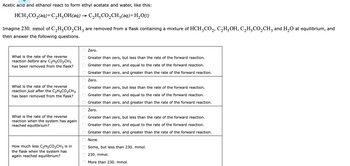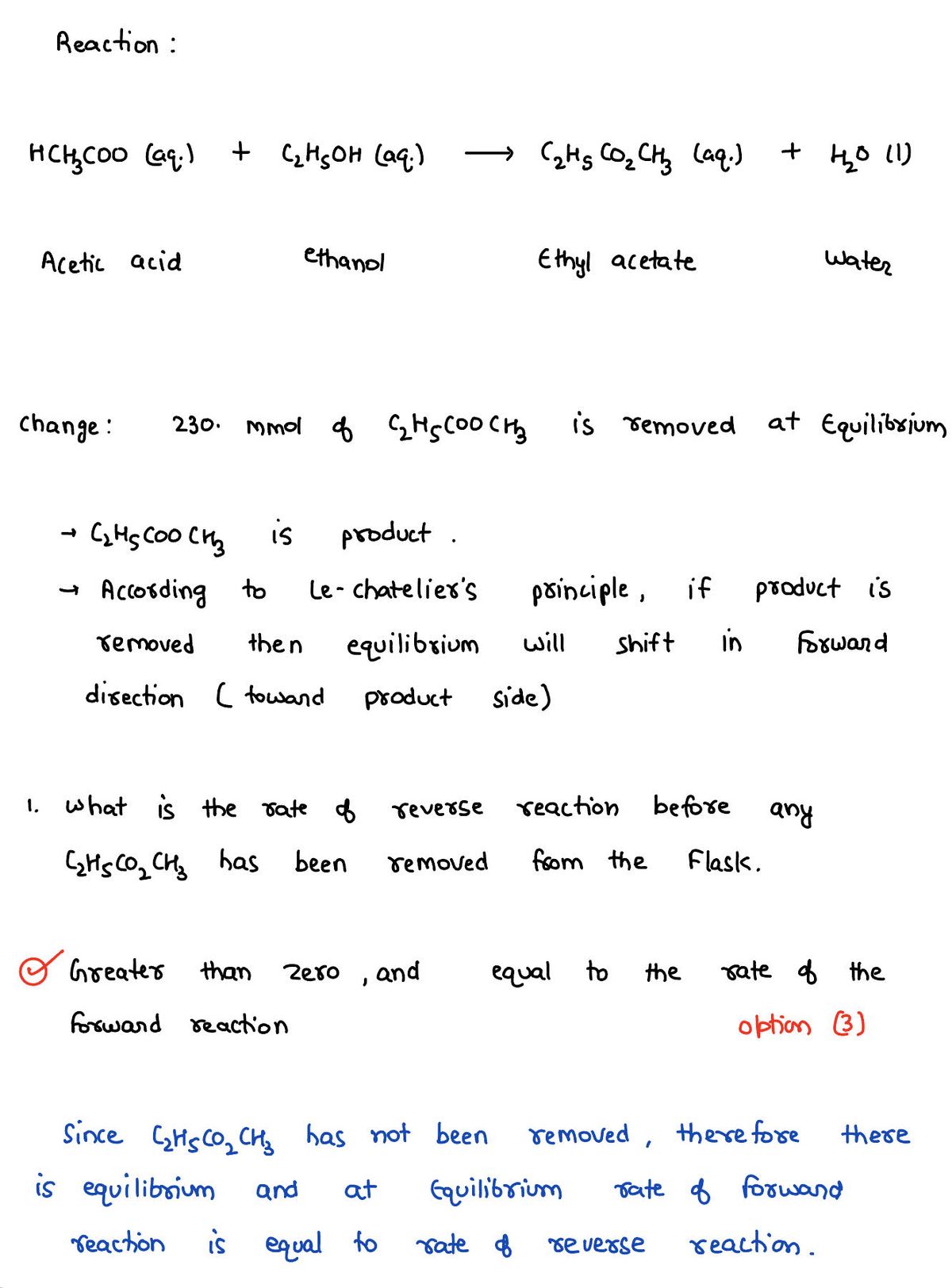
Chemistry
10th Edition
ISBN: 9781305957404
Author: Steven S. Zumdahl, Susan A. Zumdahl, Donald J. DeCoste
Publisher: Cengage Learning
expand_more
expand_more
format_list_bulleted
Concept explainers
Question

Transcribed Image Text:Acetic acid and ethanol react to form ethyl acetate and water, like this:
HCH3CO₂(aq) + C₂H²OH(aq) → C₂H₂CO₂CH₂(aq)+H₂O(1)
Imagine 230. mmol of C₂H²CO₂CH3 are removed from a flask containing a mixture of HCH³CO₂, C₂H²OH, C₂H²CO₂CH3 and H₂O at equilibrium, and
then answer the following questions.
What is the rate of the reverse
reaction before any C₂H5CO₂CH3
has been removed from the flask?
What is the rate of the reverse
reaction just after the C₂H5CO₂CH3
has been removed from the flask?
What is the rate of the reverse
reaction when the system has again
reached equilibrium?
How much less C₂H5CO₂CH3 is in
the flask when the system has
again reached equilibrium?
O O O O O O O O O O O O O O O O
Zero.
Greater than zero, but less than the rate of the forward reaction.
Greater than zero, and equal to the rate of the forward reaction.
Greater than zero, and greater than the rate of the forward reaction.
Zero.
Greater than zero, but less than the rate of the forward reaction.
Greater than zero, and equal to the rate of the forward reaction.
Greater than zero, and greater than the rate of the forward reaction.
Zero.
Greater than zero, but less than the rate of the forward reaction.
Greater than zero, and equal to the rate of the forward reaction.
Greater than zero, and greater than the rate of the forward reaction.
None.
Some, but less than 230. mmol.
230. mmol.
More than 230. mmol.
Expert Solution
arrow_forward
Step 1

Step by stepSolved in 2 steps with 2 images

Knowledge Booster
Learn more about
Need a deep-dive on the concept behind this application? Look no further. Learn more about this topic, chemistry and related others by exploring similar questions and additional content below.Similar questions
- Please show everycalculation Ive been stuck on this problem for a couple hoursarrow_forwardCan this be solved with work, please? thank you!arrow_forwardC6H12O6 O + 6O2 →→ 6CO2 + 6H2O + Energy Determine the limiting reactant and how much of that limiting reactant you would need in order to use up all of the non-limiting reactant. Assume you have 25 grams of glucose and 40 grams of oxygen as reactants for the following photosynthesis reaction: A) Glucose is the limiting reactant; You would need .1388 moles of glucose to use up all of the Oxygen (non-limiting reactant). B Glucose is the limiting reactant; You would need .208 moles of glucose to use up all of the Oxygen (non-limiting reactant). C Oxygen is the limiting reactant; You would need 1.25 moles of Oxygen to use up all of the glucose (non-limiting reactant). D Oxygen is the limiting reactant; You would need .8328 moles of Oxygen to use up all of the glucose (non-limiting reactant).arrow_forward
- The reaction A(aq) + B(aq) C(aq) + D(aq) has a ΔHrxn = -85 kJ/mol. This reaction is endorthermic or exothermic . If the temperature of the reaction mixture is increased, equilibrium will shift towards the reactans or products. This change will decrease or increase the concentration of the reactants and K will increase or deacreasearrow_forwardproduce carbon dioxide and water, as described in the following reaction: C.H»O, (s) + _ O: (g) → _ H;O (1) + CO; (g) are comearrow_forwardBe sure to answer all parts. Balance the following gas-phase reaction and write its reaction quotient, Q (0+ON(o+oN Include the physical states of all reactants and products in your balanced equation. Q=arrow_forward
- esc Phosphoric acid, which is commonly used as rust inhibitor, food additive and etching agent for dental and orthopedic use, can be synthesized using a two-step thermal process. In the first step, phosphorus and oxygen react to form diphosphorus pentoxide: P₁(1)+50₂(g) 2 P₂O(g) In the second step, diphosphorus pentoxide and water react to form phosphoric acid: P₂O(g) + 3 H₂O(1)-2 H₂PO₂(0) 4 Write the net chemical equation for the production of phosphoric acid from phosphorus, oxygen and water. Be sure your equation is balanced. 0 Continue 56°F Clear F1 J F2 @ 2 F3 # 3 Q Search F4 $ 4 F5 % 5 F6 6 0-0 X F7 & 00 7 Ś F8 © 2023 McGraw Hill LLC. All Rights Reserved. Terms of Use | Privacy Center | Accessibi M OO DELL F9 prt sc F10 home F11 end 12 F12 0 Submit Assignment J olo 18 Ar insertarrow_forwardYour lab partner accidentally mixed some sodium chloride with your sample of Epsom salts (M9SO,·7H,O). You want to make a standard solution of magnesium ion, and this is the only sample of a magnesium salt you have. To determine the amount of magnesium salt in the mixture, you heat 100.00 g to drive off the water of hydration and find that the anhydrous mixture has a mass of 73.25 g. What is the mass in grams of the original salt mixture that you must add to 1.000L of water to make a 0.1000 M solution of Mg2+ ion?arrow_forwardPhosphoric acid, which is commonly used as rust inhibitor, food additive and etching agent for dental and orthopedic use, can be synthesized using a two-step thermal process. In the first step, phosphorus and oxygen react to form diphosphorus pentoxide: P4(1)+50₂(9) 2 P₂05(9) In the second step, diphosphorus pentoxide and water react to form phosphoric acid: P₂O(g) + 3 H₂O(1)-2H₂PO4(1) ob Write the net chemical equation for the production of phosphoric acid from phosphorus, oxygen and water. Be sure your equation is balanced. XS 2arrow_forward
arrow_back_ios
arrow_forward_ios
Recommended textbooks for you
 ChemistryChemistryISBN:9781305957404Author:Steven S. Zumdahl, Susan A. Zumdahl, Donald J. DeCostePublisher:Cengage Learning
ChemistryChemistryISBN:9781305957404Author:Steven S. Zumdahl, Susan A. Zumdahl, Donald J. DeCostePublisher:Cengage Learning ChemistryChemistryISBN:9781259911156Author:Raymond Chang Dr., Jason Overby ProfessorPublisher:McGraw-Hill Education
ChemistryChemistryISBN:9781259911156Author:Raymond Chang Dr., Jason Overby ProfessorPublisher:McGraw-Hill Education Principles of Instrumental AnalysisChemistryISBN:9781305577213Author:Douglas A. Skoog, F. James Holler, Stanley R. CrouchPublisher:Cengage Learning
Principles of Instrumental AnalysisChemistryISBN:9781305577213Author:Douglas A. Skoog, F. James Holler, Stanley R. CrouchPublisher:Cengage Learning Organic ChemistryChemistryISBN:9780078021558Author:Janice Gorzynski Smith Dr.Publisher:McGraw-Hill Education
Organic ChemistryChemistryISBN:9780078021558Author:Janice Gorzynski Smith Dr.Publisher:McGraw-Hill Education Chemistry: Principles and ReactionsChemistryISBN:9781305079373Author:William L. Masterton, Cecile N. HurleyPublisher:Cengage Learning
Chemistry: Principles and ReactionsChemistryISBN:9781305079373Author:William L. Masterton, Cecile N. HurleyPublisher:Cengage Learning Elementary Principles of Chemical Processes, Bind...ChemistryISBN:9781118431221Author:Richard M. Felder, Ronald W. Rousseau, Lisa G. BullardPublisher:WILEY
Elementary Principles of Chemical Processes, Bind...ChemistryISBN:9781118431221Author:Richard M. Felder, Ronald W. Rousseau, Lisa G. BullardPublisher:WILEY

Chemistry
Chemistry
ISBN:9781305957404
Author:Steven S. Zumdahl, Susan A. Zumdahl, Donald J. DeCoste
Publisher:Cengage Learning

Chemistry
Chemistry
ISBN:9781259911156
Author:Raymond Chang Dr., Jason Overby Professor
Publisher:McGraw-Hill Education

Principles of Instrumental Analysis
Chemistry
ISBN:9781305577213
Author:Douglas A. Skoog, F. James Holler, Stanley R. Crouch
Publisher:Cengage Learning

Organic Chemistry
Chemistry
ISBN:9780078021558
Author:Janice Gorzynski Smith Dr.
Publisher:McGraw-Hill Education

Chemistry: Principles and Reactions
Chemistry
ISBN:9781305079373
Author:William L. Masterton, Cecile N. Hurley
Publisher:Cengage Learning

Elementary Principles of Chemical Processes, Bind...
Chemistry
ISBN:9781118431221
Author:Richard M. Felder, Ronald W. Rousseau, Lisa G. Bullard
Publisher:WILEY